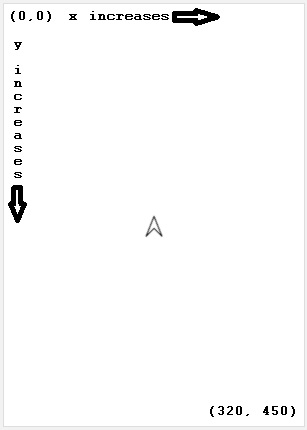- UI Controls
- onEvent
- button
- textInput
- textLabel
- dropdown
- getText
- setText
- getNumber
- setNumber
- checkbox
- radioButton
- getChecked
- setChecked
- image
- setImageURL
- playSound
- stopSound
- open
- getImageURL
- showElement
- hideElement
- deleteElement
- setPosition
- setSize
- getProperty()
- setProperty()
- write
- getXPosition
- getYPosition
- setScreen
- rgb()
- playSpeech()
- Canvas
- Data
- Turtle
- Control
- Math
- Add Operator
- Subtract operator
- Multiply operator
- Divide operator
- Equality operator
- Inequality operator
- Greater than operator
- Greater than or equal operator
- Less than operator
- Less than or equal operator
- And Operator
- Or operator
- Not operator
- randomNumber min/max
- randomNumber
- Math.round
- Math.abs
- Math.max
- Math.min
- Math.random
- Math.sqrt
- Math.pow
- Modulo operator
- Variables
- Declare and assign a value to a variable
- Declare a variable
- Assign x
- Prompt the user for a value and store it
- Prompt the user for a numerical value and store it
- console.log
- Declare and assign a string to a variable
- str.substring
- indexOf
- includes
- length
- str.toUpperCase
- str.toLowerCase
- list.length
- list.join
- insertItem
- Declare and assign an array [1,2,3] to a variable
- Declare and assign an array ["a", "b", "d"] to a variable
- Declare and assign an array to a variable
- appendItem
- removeItem
- Access List Item
- Declare an object
- getValue
- addPair
- Functions
- Advanced
- Maker
- Circuit
- onBoardEvent()
- led
- led.on()
- led.off()
- led.blink()
- led.pulse()
- led.toggle()
- colorLeds
- colorLeds[i].on()
- colorLeds[i].blink()
- colorLeds[i].toggle()
- colorLeds[i].off()
- colorLeds[i].pulse()
- colorLeds[i].stop()
- colorLeds[i].intensity()
- colorLeds[i].color()
- buzzer
- buzzer.frequency()
- buzzer.note()
- buzzer.stop()
- buzzer.play()
- accelerometer
- accelerometer.getOrientation
- accelerometer.getAcceleration
- toggleSwitch
- toggleSwitch.isOpen
- button(L/R)
- buttonL.isPressed
- buttonL.holdtime
- soundSensor.threshold
- soundSensor
- lightSensor.threshold
- lightSensor.value
- lightSensor.start
- soundSensor.value
- soundSensor.setScale()
- lightSensor
- lightSensor.setScale()
- tempSensor
- tempSensor.C
- tempSensor.F
- soundSensor.getAveragedValue
- lightSensor.getAveragedValue
- buzzer.playNotes
- buzzer.playSong
move
Category:Turtle
move(x, y)
Category: Turtle
Moves the turtle by adding x pixels to the turtle's current x position and y pixels to the turtle's current y position.
Some drawings are more easily described by movements of the turtle relative to the current turtle location. Unlike moveForward(pixels), the turtle can move in a direction different from its facing direction.
Examples
// Draw a line while moving the turtle to the right and down. move(50, 50);
Example: Turtle Direction Irrelevant Draw the same line as the previous example but with the turtle facing a different direction.
// Draw the same line as the previous example but with the turtle facing a different direction. turnRight(90); move(50, 50);
Example: Arrow Draw a arrow pointing up from a random location on the screen.
// Draw a arrow pointing up from a random location on the screen. penUp(); moveTo(randomNumber(320),randomNumber(480)); penDown(); move(0, -100); move(-25, 50); move(50, 0); move(-25, -50); |

|
Syntax
move(x, y);
Parameters
| Name | Type | Required? | Description |
|---|---|---|---|
| x | number | Yes | The number of pixels to move the turtle right. |
| y | number | Yes | The number of pixels to move the turtle down. |
Returns
No return value. Moves turtle only.
Tips
- Use penUp() before calling move(x,y) to have the turtle not draw as it moves.
- The screen default size is 320 pixels wide and 450 pixels high, but you can move the turtle off the screen by exceeding those dimensions.
- There are three ways to move the turtle in a straight line:
- Specify the number of pixels to move the turtle in the direction it is facing using moveForward(pixels) or moveBackward(pixels).
- Specify a number of pixels in the x and y direction to move the turtle using move(x,y), regardless of direction that the turtle is facing.
- Specify an x and y pixel location on the screen to move the turtle to using moveTo(x,y), regardless of direction that the turtle is facing.

Found a bug in the documentation? Let us know at documentation@code.org
Found a bug in the documentation? Let us know at documentation@code.org